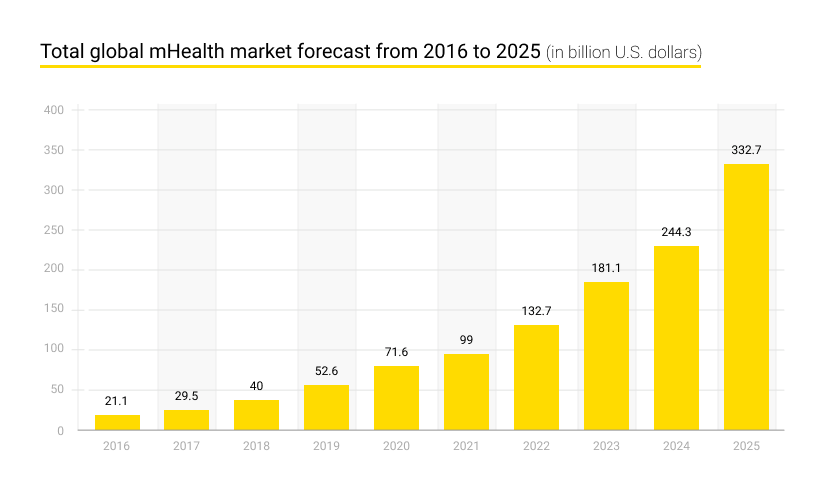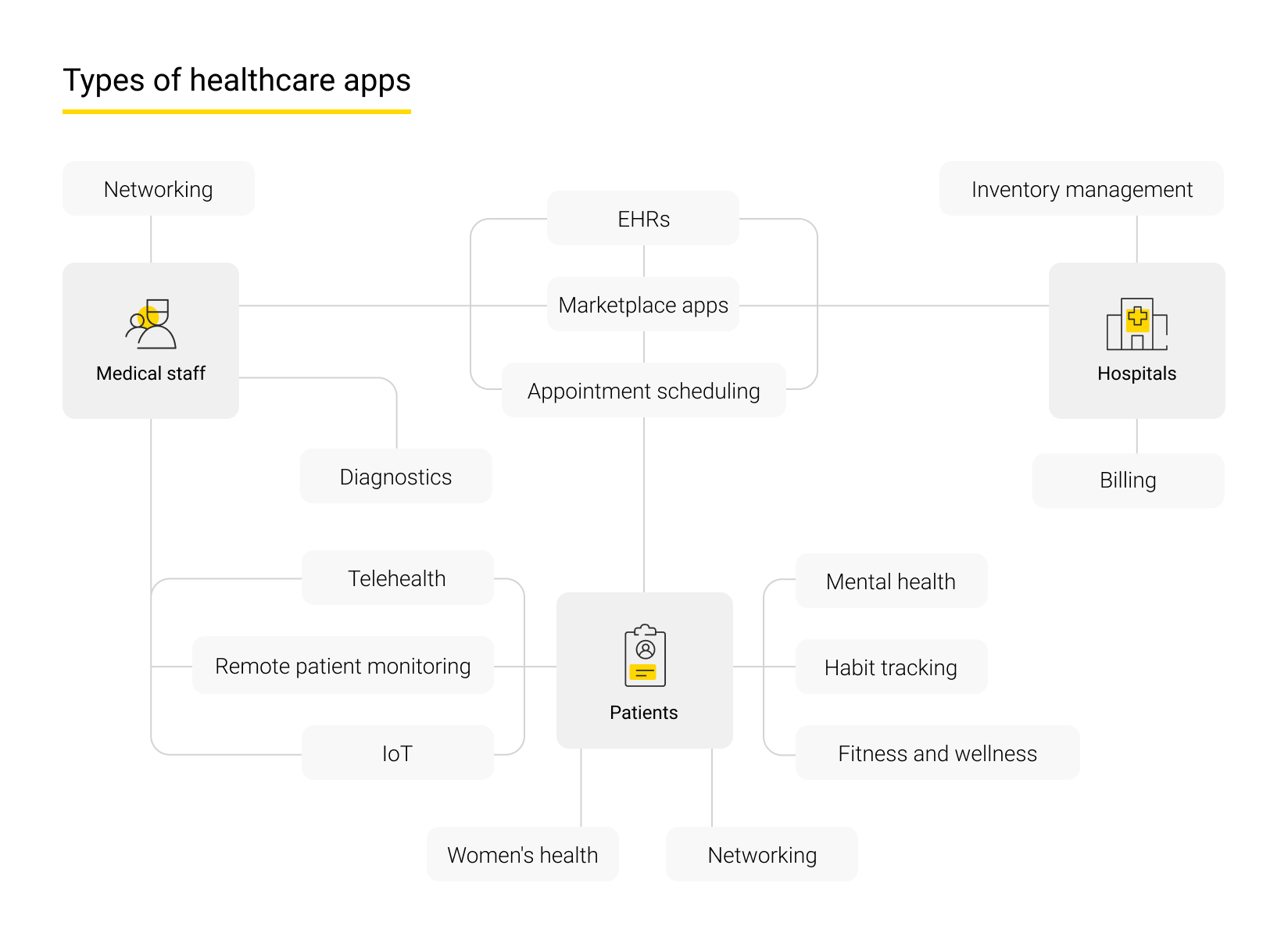- Current landscape to build a healthcare app
- An important dividing line for a clearly formulated healthcare app strategy
- End-user groups to devise your healthcare app strategy
- Observed industry trends
- What to do to build a healthcare app
- Reasons why even potentially top-notch healthcare apps may fail
- Selecting a proper custom engineering vendor for your strategy
- Wrapping up
The wave of COVID-19, coupled with its shocks, new social practices, and economic troubles, exerted an array of beneficial influences on the world of HealthTech. The urgent need for solutions, capable of assisting doctors with handling a seemingly never-ending influx of patients in a time-saving, distant, and accurate fashion, boosted the progress of tools in several areas. These encompass digital therapeutics, telehealth, and RPM. That impetus, along with the constantly evolving smartphone technology and other contemporary trends (e.g. the introduction of 5G, exploitation of Big Data and Blockchain, application of IoT in healthcare) have propelled mobile health app engineering to an entirely new level.
At this previously unseen level, if you’re contemplating the creation of a healthcare app, strategy is to be your priority.
Here are some of Andersen’s thoughts on how to develop a healthcare app, based on a fine-tuned strategy.
Current landscape to build a healthcare app
Back in 2020, the estimated global mHealth market stood at almost $72 billion, with forecasts indicating a potential growth trajectory towards almost $333 billion around 2025. More than impressive, indeed.

Speaking of the most lucrative subsegments in which you could build something new, they include:
- Healthcare-focused AI;
- Telehealth;
- Women’s health;
- Regenerative medicine.
An important dividing line for a clearly formulated healthcare app strategy
Having clarified the overall dynamics and the brightest directions, let’s take a step back. A clear understanding of your app is a must-have for any fruitful strategy. Thus, let’s define what particular healthcare type your app is going to belong to.
For that, it is the right moment to briefly delineate the existing distinctions between the primary categories of domain-specific apps: i.e. healthcare apps and medical apps. Despite their apparent similarities, it's vital for forward-thinking and detail-oriented investors to recognize the major disparity in their objectives, operational foundations, and applicable strategies.
We, in the capacity of a healthcare app development services vendor, would like to pin down these specificities.
Medical apps and their factors of importance for your strategy:
- When you design and build them, keep their professional treatment activities in mind;
- For precise diagnosis, remember that they utilize data analytics;
- You must build them in strict accordance with industry guidelines and regulations;
- It takes a lot of time, effort, resources, and sophisticated technologies to build them.
Health apps and relevant considerations concerning strategy:
- They target a broad end-user demographic;
- They offer recommendations without relying on highly accurate analytics capabilities;
- When you intend to build an app of this class, you are not bound by stringent regulatory requirements;
- They are classified as more cost- and resource-effective to build.
It's important to mention that the product vision, specs, and structure heavily hinge on the exact category your plans fall into. Once a decision is reached, the next step is selecting a niche where your idea has the greatest potential for success.
End-user groups to devise your healthcare app strategy
To significantly raise your chances of securing a rewarding ROI, you need to build an app that satisfies the individual requirements experienced by a given end-user group. Normally, three sorts of tasks can potentially be involved: serving patients, upgrading operations carried out by healthcare facilities as a whole, or alleviating the burden dealt with by healthcare workers.

- If you build a healthcare app for patients, you might attempt to allow them to make appointments, receive notifications, pay for services provided, upload test results, consult with specialists remotely, network with other end-users, etc. This class also comprises health tracking apps that update the end-users on their vital sign dynamics, empower them to exercise control over their workouts and eating routines, as well as encourage healthier lifestyles in other respects (i.e. adequate sleeping practices);
- If you build a healthcare app for medics, your scope might include providing for remote patient monitoring features, conducting telehealth sessions, managing schedules, exchanging protected messages and docs, making job-related calls, etc. Usually, a professional healthcare app is integrated with EHRs systems for better data gathering and diagnostics;
- If you build a healthcare app for entire facilities, it will be designed to effectively manage inventory, payments, hospital staff schedules and appointments, databases, etc.
Observed industry trends
After selecting your digital product class, it would be beneficial for your healthcare app strategy to consider the most impactful trends, framing the market of today.
AI and ML: What to build within your strategy
Intelligent assistants are revolutionizing various facets of healthcare, spanning from robotic surgeries to the creation of intelligent chatbots and medical education tools. By harnessing algorithms to sift through vast datasets, monitor vital signs, interpret medical images, and detect recurring patterns, these technologies enable rapid and precise diagnoses across entire spectra of health conditions, including mental illnesses, oncology, and beyond.
Furthermore, pharmaceutical firms are embracing AI and ML to propel advancements in their research and developmental endeavors.
Blockchain: Things to build within your strategy
Blockchain technology, a still relatively young innovation, has demonstrated its efficacy in creating decentralized patient portals and enabling insurance firms to securely access their clients' medical data. It seamlessly integrates with EHRs and facilitates permission-based access to patient info, ensuring enhanced data security. Additionally, blockchain is instrumental in optimizing logistics and accurately tracking medications and other medical goods throughout supply chains E2E.
IoT: Features to build within your strategy
The latest IoT-based advancements have exceeded the limits of mere vital sign collection via wearable technology in healthcare. As of now, such solutions are broadly employed for seamlessly managing inventory, tracking the transportation of medicinal products and organs in real-time, addressing chronic conditions, enhancing surgery aftercare, etc.
Big Data: Capabilities to build within your strategy
The streams of different types of heterogeneous data obtained from countless IoT-connected devices and smart algorithms grows exponentially. Thus, analytics tools and databases that are capable of sorting and processing this immensity of info are a must-have in sophisticated and scalable solutions.
VR/AR: What else to build within your strategy
These cutting-edge technologies are invaluable when it comes to educating and training inexperienced professionals within a secure setting, facilitating therapy sessions, and devising indoor navigation solutions. Explore the opportunities of integrating them into your app to aid surgeons, tackle mental health issues, and overcome other hurdles, if applicable and feasible.
What to do to build a healthcare app
When considering how to develop a healthcare app, we at Andersen recommend following this strategy, step by step.
Strategy: Undertake preparatory market and end-user research.
Understanding the market landscape, analyzing rivals' strengths and weaknesses, and grasping the needs and challenges of your target audience are essential to build a commercially successful offering. Engaging subject matter experts with medical backgrounds as well as profound insights into different healthcare providers and segment dynamics will give you valuable assets at this phase.
Strategy: Elicit digital product requirements and craft prototypes.
The next thing to do is elicit and prioritize requirements to implement and features to build. This phase is necessitated by the need to draw up and test clickable prototypes. Knowledgeable BAs and IT architects are indispensable resources for this task.
Engaging their expertise upfront can streamline your development process, ultimately saving both time and money by establishing a well-defined project framework from the outset.
Typically, healthcare mobile solutions incorporate several key features: user-friendly interfaces for intuitive navigation, notification functionalities, secure payment processing, communication tools like chat and video calls, and seamless integration with external services, e.g. Google Fit, HealthKit, and GPS.
Strategy: Build an MVP.
Think about releasing a basic, really simplified, version containing only the core features. By doing so, you can test it with end-users and then incrementally improve the initial outcomes. This approach not only helps one achieve a faster return on investment but also minimizes the need for expensive revisions down the line.
Strategy: Prepare for upcoming iterations.
To be capable of scaling and extending the MVP deliverables and keeping the product synched with the latest OS updates for elimination of technical debt, choose a software engineering partner that offers support and maintenance.
Reasons why even potentially top-notch healthcare apps may fail
Even initiatives that seem promising and are based on a well-thought-out strategy may fail, in spite of all the resources allocated. To avoid this, we suggest you examine the following likely pitfalls. Make sure that your strategy takes them into account.
Strategy flaw #1. Overly complex architectures and unwieldy designs impede usability. High-quality software requires simplicity, ease of use, and a degree of aesthetic appeal. End-users should be in the right position to navigate effortlessly, without grappling with a cluttered interface. In healthcare, it's crucial to acknowledge potential end-users with disabilities, elderly individuals, cognitively impaired people, etc., and prioritize accessibility and minimalism, ensuring lucid and concise content presentation.
Strategy flaw #2. Ignoring regulatory requirements is not an option if you seek acceptance for your software among major market players and stores. It's imperative to stick to regulations, especially those focused on ensuring financial operation security and meeting standards imposed by the FDA or other regulatory agencies, among other things.
Strategy flaw #3. Inadequate data protection poses significant risks. Most end-users hesitate to trust their data to any solution if they harbor doubts about its security. And recent incidents all over the world prove that even the leading healthcare apps face the threat of data breaches. Hence, it's essential to prioritize robust API integrations and employ proven data encryption methods to ensure data safety.
Selecting a proper custom engineering vendor for your strategy
For a robust solution delivered within set timelines, devoid of hidden expenses, and supported by transparent processes, partnering with a dependable IT vendor is paramount. Here are some key considerations to help you opt for the right candidate who is fully prepared to realize your strategy:
Verified regulatory compliance for your strategy
The partner you choose must be a HIPAA- and GDPR-compliant one. Make sure to verify this. On top of that, they should adhere to various standards such as the HITECH act, Human Interface Guidelines, the Data Protection Act, etc., pertaining to your app’s class and the geographic area for localization efforts.
Deep relevant expertise for your strategy
Validate that your vendor actually can augment your initiatives with not only skilled technical specialists proficient in fresh tech stacks but also subject-matter experts, well-versed in the domain landscape. The team should encompass experienced PMs, BAs, marketing professionals, and other specialists, not limited to engineering and testing, capable of crafting and executing a business strategy with clearly outlined objectives and requirements.
Access to Agile and DevOps potential for your strategy
Operating within shorter time frames and releasing functional components at the conclusion of each interval enables your team to promptly identify flaws and dynamically respond to potential alterations. Implementing continuous integration and delivery further enables comprehensive testing of your app while continually developing or enhancing its capabilities.
Wrapping up
To adroitly build healthcare apps that enable professionals to deliver help, diagnose, and trace treatment progress in a timely and accurate fashion requires an increased level of quality. This contributes to safety, accessibility, and availability of care.
If you are searching for bespoke healthcare app engineering services with state-of-the-art deliverables, mature processes, and profound technical expertise, contact Andersen’s team for a free consultation. Our advice is informative, insightful, and actionable!



